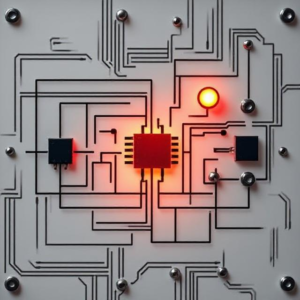What is Transistor-Level Circuit Design?
Transistor-level circuit design refers to creating electronic circuits by arranging and connecting transistors (tiny switches) to control the flow of electrical signals in a desired way. This is the lowest level of designing in electronics, where the design focuses on the behavior and connections of individual transistors.

What is a Transistor?
A transistor is like a tiny electronic switch that can turn electrical signals on or off, or make them stronger. Transistors are essential components in all modern electronic devices (like smartphones, computers, and TVs) because they help control and amplify signals.
How Does Transistor-Level Circuit Design Work?
Imagine you’re trying to design a very basic circuit to turn on a light when you press a button. At the transistor level, you’d use transistors to control the flow of electricity. Here’s how it works:
- Transistor as a Switch:
- When you apply a small electrical signal (called the “input”) to a transistor, it can either allow a larger current (electricity) to flow through (turning the light on) or block the current (turning the light off).
- In some designs, transistors work together to form logic gates that can do tasks like “AND” or “OR” (just like math). For example, an AND gate might only let electricity through if two conditions are met.
- Combining Transistors:
- In more complex circuits, you combine many transistors in different ways to achieve more advanced functions. For example, a computer processor uses millions of transistors to process information, do calculations, and run applications.
- Circuit Design:
- Transistor-level circuit design involves deciding where each transistor should go, how they are connected, and how they interact with each other to create the desired output (like amplifying a sound or processing data in a computer).
- Simulation and Testing:
- After designing the circuit at the transistor level, engineers use simulations to test how the circuit will behave. They check if it works as expected before actually building it out.
Why is Transistor-Level Circuit Design Important?
- Precision: Transistor-level design allows for precise control over how each part of the circuit behaves. This is crucial for creating efficient, powerful, and reliable devices.
- Building Blocks of Electronics: Transistor-level designs are the building blocks for larger, more complex circuits. Without good transistor-level designs, it would be difficult to make things like processors, memory chips, or even simple amplifiers.
- Efficiency and Performance: Designing circuits at the transistor level helps to create circuits that are both fast and energy-efficient, which is especially important in modern gadgets like smartphones and computers that need to process lots of data quickly while saving battery.
Where is Transistor-Level Circuit Design Used?
- Microprocessors: Inside computers, phones, and other devices, transistor-level design is used to create processors (the “brain” of the device) that handle calculations and data processing.
- Amplifiers: Used in audio equipment or radios to amplify weak signals and make them stronger.
- Digital Circuits: Used in logic circuits, like those in calculators or digital watches.
- Integrated Circuits (ICs): Many complex electronic systems are made up of multiple transistors connected together in a chip (IC), which is designed at the transistor level.
Summary:
- Transistor-level circuit design means designing circuits using individual transistors (tiny switches that control electrical signals).
- Engineers arrange and connect transistors to create circuits that can process signals, amplify them, or perform tasks like calculations.
- It’s important because it allows us to build powerful, fast, and efficient electronic devices like computers, smartphones, and more.
Tags: Amplifiers, AND gate, Audio Equipment, Circuit Components, circuit design, circuit functionality, circuit layout, Circuit Optimization, Circuit performance, Circuit precision, Circuit Simulation, circuit testing, Computer processors, data processing, Digital circuits, Digital devices, electrical circuit analysis, electrical engineering, electrical signals, electronic circuits, electronic devices, Electronic devices design, Electronics Design, Energy-efficient circuits, Integrated Circuits (ICs), Logic circuit design, Logic Gates, Microprocessors, Mobile electronics, modern electronics., OR gate, Power Efficiency, radio signals, semiconductor, Signal amplification, Signal flow control, Signal Processing, Smartphone processors, switch, transistor, transistor applications, Transistor arrangement, transistor behavior, Transistor circuit design, Transistor connections, Transistor switch, Transistor switching, Transistor technology, Transistor-level design, transistors


